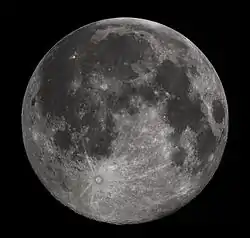Libration
In lunar astronomy, libration is the wagging or wavering of the Moon perceived by Earth-bound observers and caused by changes in their perspective. It permits an observer to see slightly different hemispheres of the surface at different times. It is similar in both cause and effect to the changes in the Moon's apparent size due to changes in distance. It is caused by three mechanisms detailed below, two of which are causing a relatively tiny physical libration via tidal forces exerted by the Earth. Such true librations are known as well for other moons with locked rotation.
| Look up libration in Wiktionary, the free dictionary. |

The quite different phenomenon of a trojan asteroid's movement has been called Trojan libration; and Trojan libration point means Lagrangian point.
Lunar libration
The Moon keeps one hemisphere of itself facing the Earth, due to tidal locking. Therefore, the first view of the far side of the Moon was not possible until the Soviet probe Luna 3 reached the Moon on October 7, 1959, and further lunar exploration by the United States and the Soviet Union. This simple picture is only approximately true: over time, slightly more than half (about 59% in total) of the Moon's surface is seen from Earth due to libration.[1]
The following are the three types of lunar libration:
- Libration in longitude results from the eccentricity of the Moon's orbit around Earth; the Moon's rotation sometimes leads and sometimes lags its orbital position. The lunar libration in longitude was discovered by Johannes Hevelius in 1648.[2] It can reach 7°54′ in amplitude.[3]
- Libration in latitude results from a slight inclination (about 6.7°) between the Moon's axis of rotation and the normal to the plane of its orbit around Earth. Its origin is analogous to how the seasons arise from Earth's revolution about the Sun. Galileo Galilei is sometimes credited with the discovery of the lunar libration in latitude in 1632,[2] although Thomas Harriot or William Gilbert might have done so before.[4] Note Cassini's laws. It can reach 6°50′ in amplitude.[3]
- Diurnal libration is a small daily oscillation due to Earth's rotation, which carries an observer first to one side and then to the other side of the straight line joining Earth's and the Moon's centers, allowing the observer to look first around one side of the Moon and then around the other—since the observer is on Earth's surface, not at its center. It reaches less than 1° in amplitude.[3]
See also
References
- Spudis, Paul D. (2004). "Moon". World Book at NASA. Archived from the original on July 3, 2013. Retrieved May 27, 2010.
- Jacqueline Bergeron, ed. (2013). Highlights of Astronomy: As Presented at the XXIst General Assembly of the IAU, 1991. Springer Science & Business Media. p. 521. ISBN 9401128286.
- Ratkowski, Rob; Foster, Jim (May 31, 2014). "Libration of the Moon". Earth Science Picture of the Day.
- Stephen Pumfrey: Harriot’s Maps of the Moon: New Interpretations. Notes Rec. R. Soc. 63, 2009, doi:10.1098/rsnr.2008.0062.
- J. Derral Mulholland, Eric C. Silverberg (1972). "Measurement of Physical Librations Using Laser Retroreflectors". Earth, Moon, and Planets. 4 (1–2): 155–159. Bibcode:1972Moon....4..155M. doi:10.1007/BF00562923.
- Moore, Sir Patrick (2003). Philip's Atlas of the Universe. Foreword by Sir Arnold Wolfendale. Philip's. ISBN 978-0-540-08707-5. OCLC 51966591.
External links
- Libration of the Moon from educational website From Stargazers to Starships
- Astronomy Picture of the Day: 2005 November 13 – time-lapse animation of the Moon through one complete cycle, hosted by NASA
- Libration: 2 years in 2 seconds – 24 full moon pictures taken over two years, compiled in an animation (linked on page) showing the Moon's libration and variations in apparent diameter
- Observing the Lunar Libration Zones
.gif)

